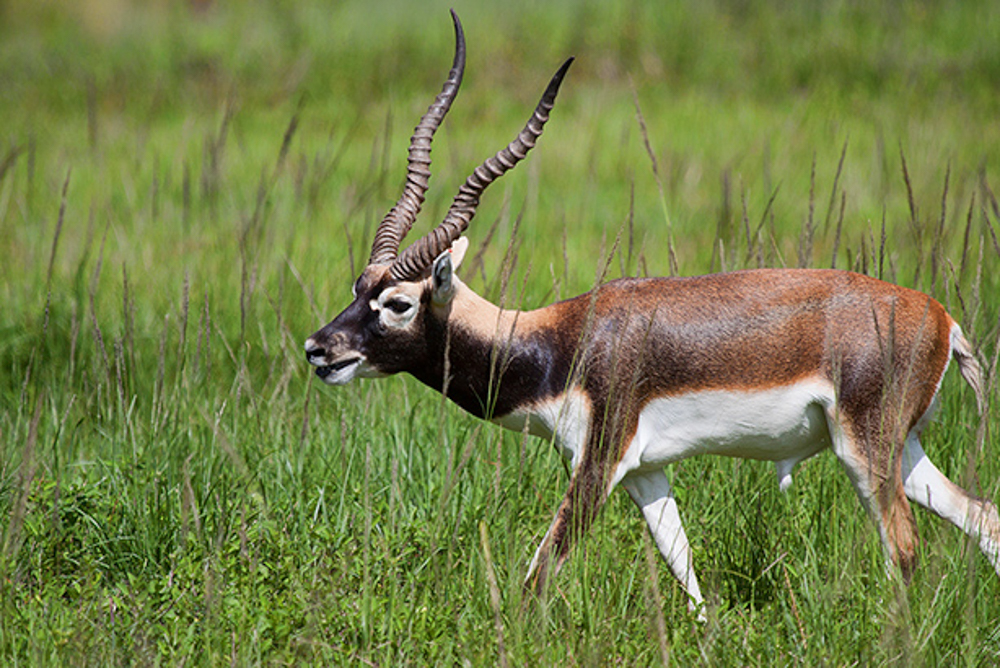In the vast grasslands of the Indian subcontinent, amidst the swaying savannas and arid plains, roams a creature of remarkable grace and beauty—the Blackbuck. Revered for its striking appearance and agile movements, the Blackbuck holds a special place in the ecosystem and cultural heritage of its native lands. Let us embark on a journey to unravel the mystique surrounding this enigmatic antelope, delving into its biology, behavior, conservation status, and cultural significance.
Biology and Morphology
Scientifically known as Antilope cervicapra, the Blackbuck is a species of antelope belonging to the Bovidae family. Characterized by its sleek, slender build and distinctive coloration, the male Blackbuck boasts spiraled, lyre-shaped horns, while females exhibit no horns or smaller, more delicate ones. Their coats vary in color from deep black to dark brown on the upper parts, with a contrasting white underbelly and facial markings.

Habitat and Distribution
Historically, Blackbucks roamed across vast expanses of the Indian subcontinent, from Pakistan to Nepal and into parts of Bangladesh. They predominantly inhabit grasslands, open plains, and scrublands, favoring areas with sparse vegetation where they can graze freely. However, due to habitat loss and fragmentation, their range has significantly diminished, leading to localized populations in protected areas and private reserves.
Behavior and Social Structure
Blackbucks are diurnal and primarily herbivorous, feeding on grasses, leaves, and occasionally, fruits. They are popular for their remarkable speed and agility, capable of reaching speeds of up to 80 kilometers per hour when fleeing from predators or engaging in territorial disputes. Despite their solitary foraging habits, Blackbucks form loose herds, especially during the breeding season, when males establish territories and compete for mating rights with females.
Reproduction and Life Cycle
Breeding typically occurs during the monsoon season, from July to September, when food resources are abundant. During this time, males engage in elaborate displays of dominance, including ritualized fights and territorial marking. After a gestation period of around six months, females give birth to a single calf, which remains hidden in dense vegetation for the first few weeks of its life. Young Blackbucks reach sexual maturity at around two years of age and may live for up to 15 years in the wild.
Conservation Status
Despite being revered in Indian culture and mythology, Blackbucks face numerous threats to their survival, including habitat loss, poaching, and predation. As a result, they are listed as Near Threatened on the International Union for Conservation of Nature (IUCN) Red List. Conservation efforts, including the establishment of protected areas, habitat restoration initiatives, and anti-poaching measures, are crucial for ensuring the long-term survival of this iconic species.
Cultural Significance
The Blackbuck holds immense cultural significance in India, where it is revered as a symbol of beauty, grace, and speed. It features prominently in traditional art, literature, and folklore, often depicted in paintings, sculptures, and classical dance forms. In addition to its cultural importance, the Blackbuck plays a vital role in maintaining the ecological balance of its native habitats, serving as both prey and predator in the intricate web of grassland ecosystems.
Conclusion
In the vast tapestry of the natural world, the Blackbuck stands out as a testament to the beauty and resilience of life on Earth. From its graceful movements on the open plains to its symbolic significance in Indian culture, this majestic antelope embodies the essence of wilderness and wonder. As stewards of our planet, it is our collective responsibility to safeguard the Blackbuck and its habitat for future generations to cherish and admire.









